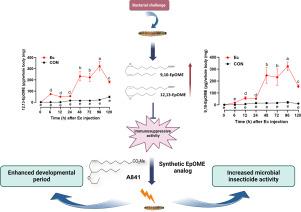EpOME mediates the immune resolution and its alkoxide analog enhances the virulence of microbial insecticides against the legume pod borer, Maruca vitrata
IF 4
1区 农林科学
Q2 BIOCHEMISTRY & MOLECULAR BIOLOGY
引用次数: 0
Abstract
Excessive and unnecessary immune responses cause serious adverse effects due to self-tissue damage and energy consumption, particularly at the late stage of infection to terminate the induced immunity. Unlike mammals, which use long-chain fatty acid oxylipins, C18 oxygenated polyunsaturated fatty acids are suggested to act as immune resolvins in insects, including two epoxyoctadecamonoenoic acids (9,10-EpOME and 12,13-EpOME). This study investigated the physiological roles of EpOMEs in immune resolution in the lepidopteran insect, Maruca vitrata. The levels of two EpOMEs in the larvae increased during the late infection stage upon immune challenge. At their peak concentrations at 96 h post-infection (pi), both EpOMEs were found at similar levels: 323.18 pg/mg body weight for 9,10-EpOME and 322.07 pg/mg body weight for 12,13-EpOME. Both EpOMEs inhibited cellular and humoral immune responses, with 12,13-EpOME being more potent than 9,10-EpOME. Genes associated with EpOME synthase and degradation, identified as Mv-CYP1 and Mv-sEH, were detected in various developmental stages and tissues of M. vitrata. RNA interference (RNAi) targeting Mv-CYP1 failed to inhibit the immune response, whereas RNAi targeting Mv-sEH enhanced the immunosuppression. In contrast to the acute (< 12 h pi) immune response involving eicosanoid biosynthesis, the expression of these two genes linked to EpOME metabolism increased significantly at the late infection stage (> 12 h pi). Several alkoxide analogs of EpOME, with the epoxide group replaced by an alkoxide group, were synthesized; one such derivative demonstrated substantially greater efficacy than the natural EpOMEs in inhibiting the immune response. Additionally, using EpOME alkoxide significantly increased the effectiveness of microbial insecticides. Moreover, exposing young larvae to sublethal doses of EpOME alkoxide or sEH inhibitor induced severe developmental delays. These results suggest a novel strategy for insect pest control using insect immune resolvin analogs.

表皮生长因子介导免疫解毒,其氧化烷类似物可增强微生物杀虫剂对豆荚螟的毒力
由于自身组织损伤和能量消耗,过度和不必要的免疫反应会造成严重的不良影响,尤其是在感染后期终止诱导免疫。与哺乳动物使用长链脂肪酸氧脂素不同,C18含氧多不饱和脂肪酸被认为可作为昆虫的免疫解毒素,其中包括两种环氧十八碳烯酸(9,10-EpOME 和 12,13-EpOME)。本研究调查了 EpOMEs 在鳞翅目昆虫 Maruca vitrata 免疫调节中的生理作用。在感染后期,幼虫体内两种 EpOMEs 的水平在受到免疫挑战时有所增加。在感染后96小时(π)的峰值浓度下,两种EPOME的水平相似:9,10-EpOME为323.18 pg/mg体重,12,13-EpOME为322.07 pg/mg体重。两种 EpOME 都能抑制细胞和体液免疫反应,12,13-EpOME 的抑制作用比 9,10-EpOME 更强。在M. vitrata的不同发育阶段和组织中都检测到了与EPOME合成酶和降解相关的基因,即Mv-CYP1和Mv-sEH。针对 Mv-CYP1 的 RNA 干扰(RNAi)未能抑制免疫反应,而针对 Mv-sEH 的 RNAi 则增强了免疫抑制。与涉及二十碳烷生物合成的急性(12 h pi)免疫反应不同,在感染晚期(12 h pi),与 EpOME 代谢有关的这两个基因的表达显著增加。研究人员合成了几种环氧基团被烷氧基取代的 EpOME 烷氧基类似物;其中一种衍生物在抑制免疫反应方面的功效大大高于天然 EpOME。此外,使用 EpOME 烷氧基还能显著提高微生物杀虫剂的效果。此外,将幼虫暴露于亚致死剂量的 EpOME 氧化烷或 sEH 抑制剂会导致严重的发育迟缓。这些结果表明,利用昆虫免疫解毒类似物控制害虫是一种新策略。
本文章由计算机程序翻译,如有差异,请以英文原文为准。
求助全文
约1分钟内获得全文
求助全文
来源期刊
CiteScore
7.00
自引率
8.50%
发文量
238
审稿时长
4.2 months
期刊介绍:
Pesticide Biochemistry and Physiology publishes original scientific articles pertaining to the mode of action of plant protection agents such as insecticides, fungicides, herbicides, and similar compounds, including nonlethal pest control agents, biosynthesis of pheromones, hormones, and plant resistance agents. Manuscripts may include a biochemical, physiological, or molecular study for an understanding of comparative toxicology or selective toxicity of both target and nontarget organisms. Particular interest will be given to studies on the molecular biology of pest control, toxicology, and pesticide resistance.
Research Areas Emphasized Include the Biochemistry and Physiology of:
• Comparative toxicity
• Mode of action
• Pathophysiology
• Plant growth regulators
• Resistance
• Other effects of pesticides on both parasites and hosts.

 求助内容:
求助内容: 应助结果提醒方式:
应助结果提醒方式:


